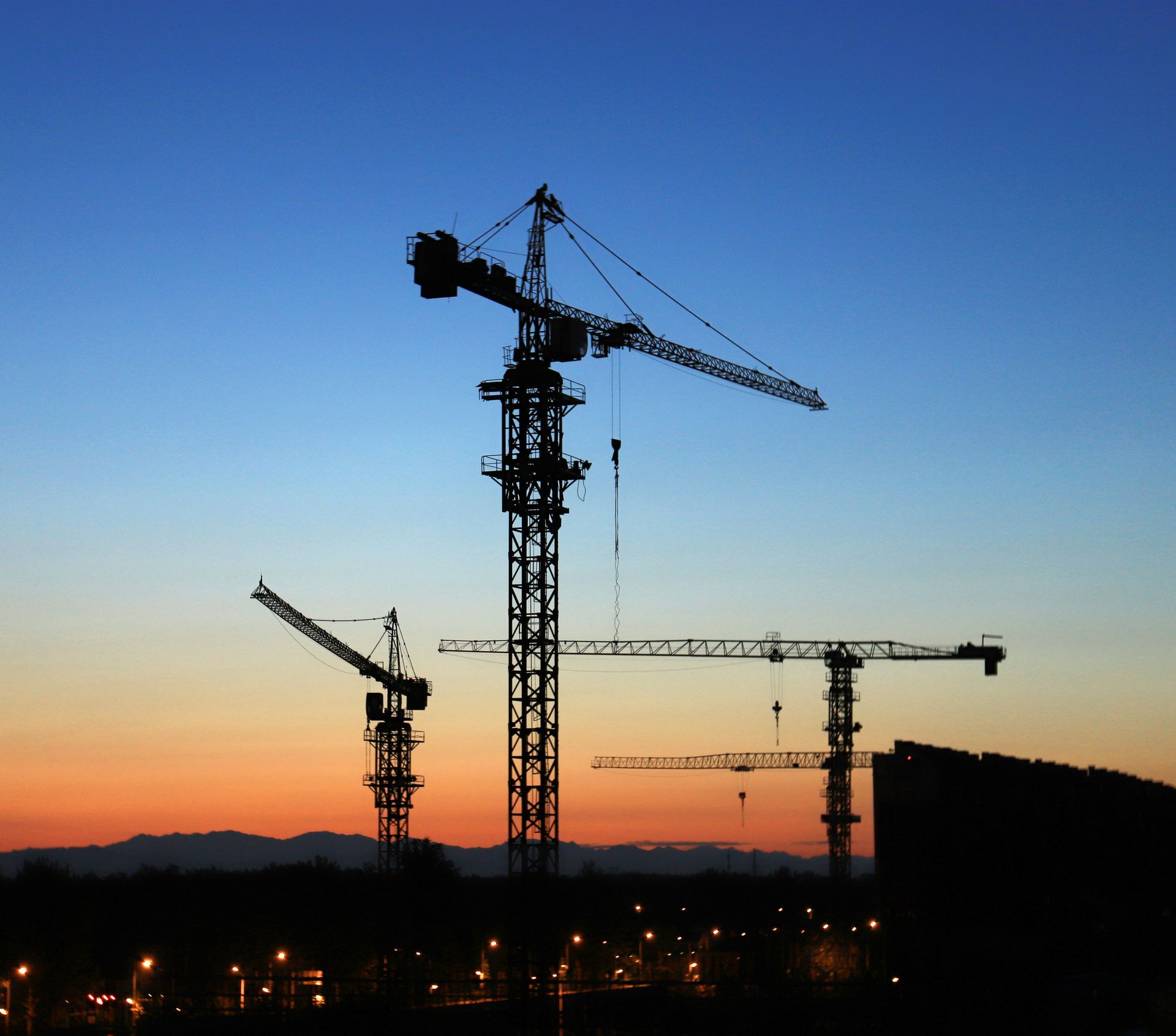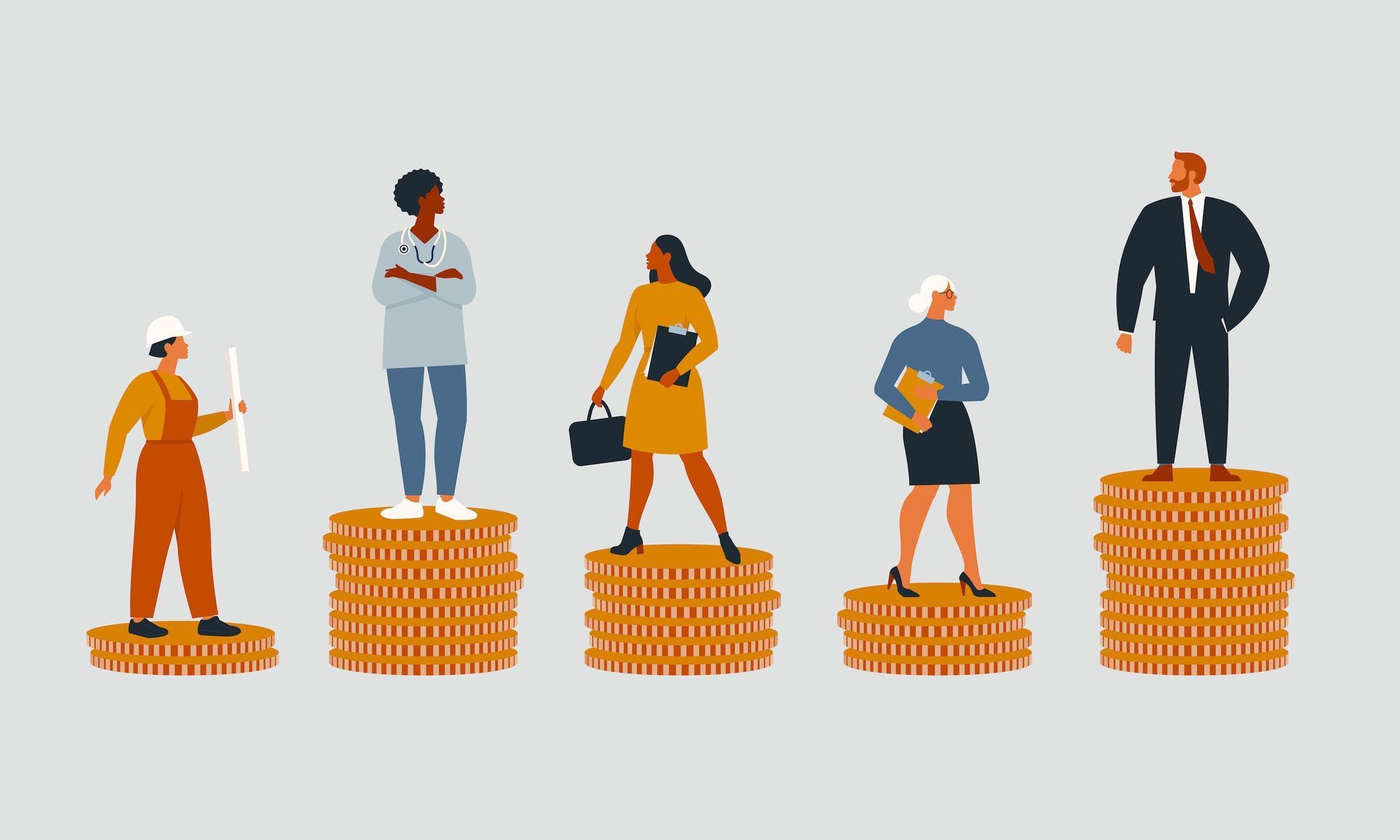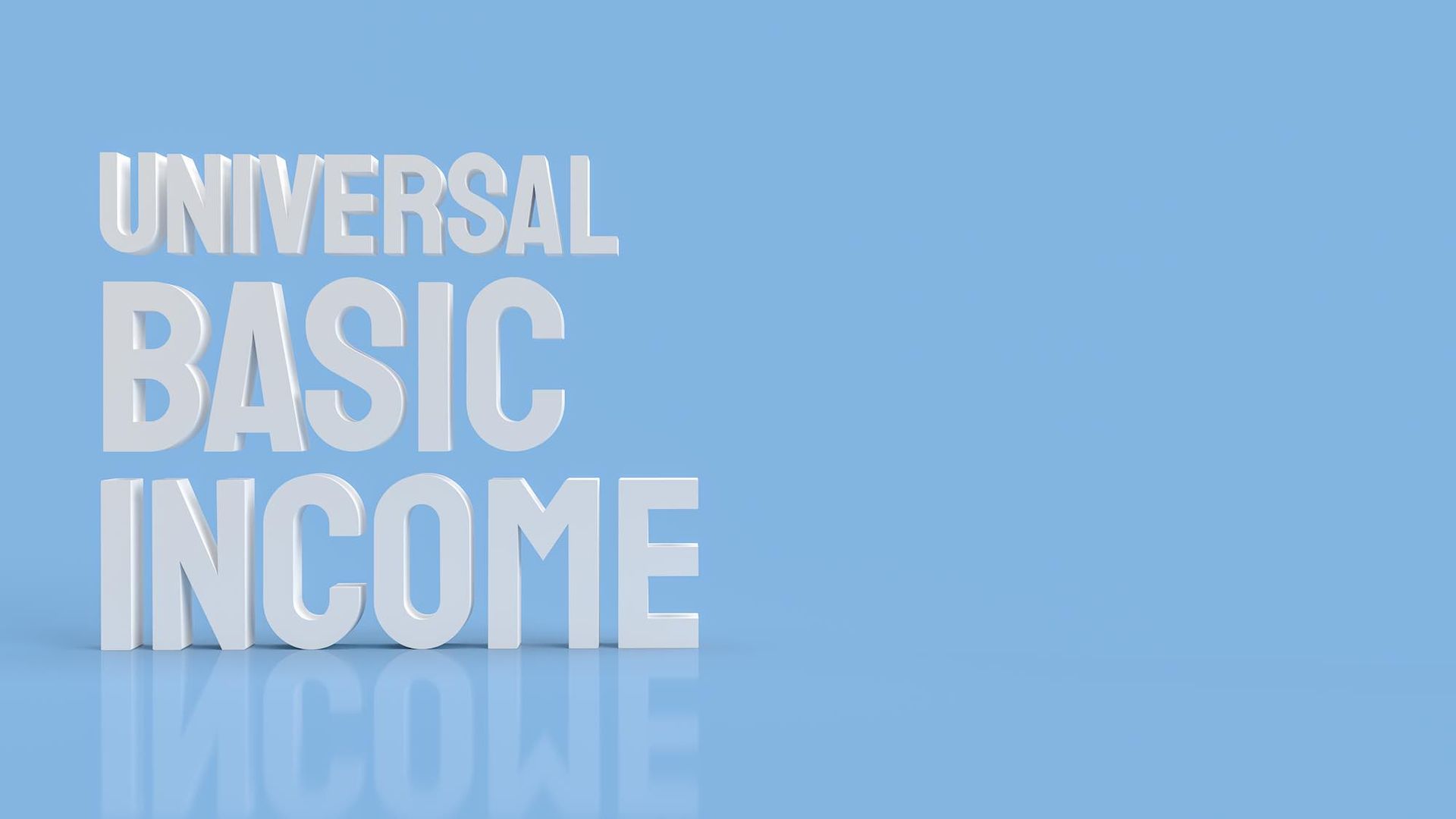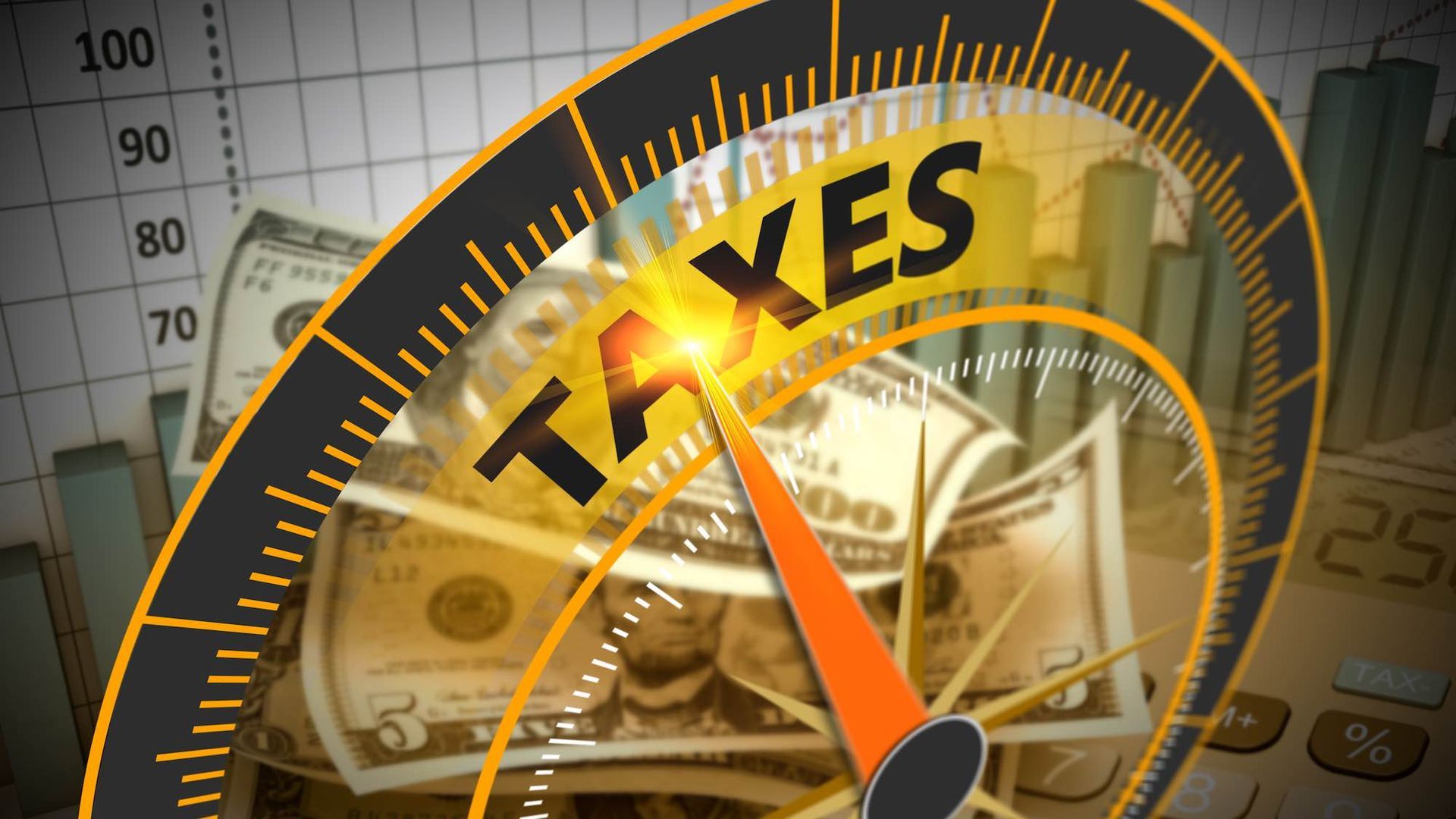Survey Results
What you told us about Wealth and Income Disparity
The Center for Study and Advocacy to Reduce Wealth and Income Inequality, d/b/a Wealth Income Equity (WIE) recently conducted a number of surveys to assess attitudes regarding wealth and income inequality and potential remedies. Thank you to those who participated.
The survey was designed by a WIE survey team and piloted among subscribers. The pilot provided valuable input for the public survey. The public survey conducted by California Survey Research Services and distributed nationwide yielded over 400 responses. A follow up survey among subscribers was also completed. The pilot and subscriber surveys yielded 60 respondents.
In addition to attitudinal responses, data was collected on age, race, U.S. State and income; gender was not included. We believe the results are indicative of a significant cross section of the U.S. public. However, the survey responses cannot claim that it is a bona fide representation of all Americans given that those lacking internet access, adequate reading comprehension, an income less than $50,000 annual, those under the age 21 or individuals having a primary language other than English or Spanish were effectively not included in the survey.
Results
Most questions were posed on a Likert scale from strongly agree to strongly disagree. Some questions required a rank ordering of priorities. For analysis purposes strongly agree and agree were collapsed as was strongly disagree and disagree.
When asked whether respondents believed that wealth and income disparity was a problem, whether greater efforts to reduce wealth and income disparity were required and whether everyone has some responsibility to engage in efforts to reduce wealth and income disparity; approximately two thirds agreed or strongly agreed.
As to whether levying
taxes on the very wealthy would make a difference and whether
there is political will to do so; about one-half agreed or strongly agreed.
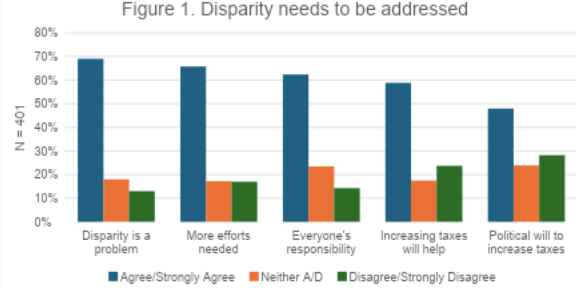
We inquired about respondent strategic priorities to reduce wealth and income disparity. 42% elected education and training followed by guaranteed basic income at 29% and worker owned businesses at 26%. It was notable that only 9% elected longer term organizing, advocacy, policy change or electoral politics as a priority.
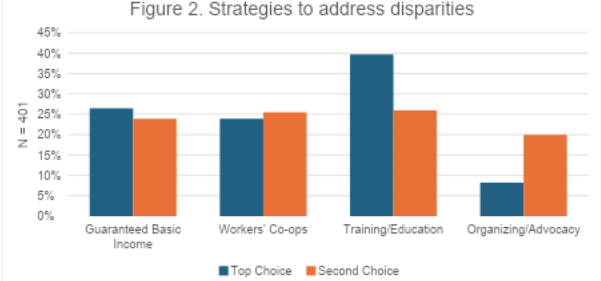
Given the history in recent decades regarding congressional and executive initiatives that in fact have reduced and not raised taxes on the wealthy, we were interested in ascertaining attitudes as to whether a modest contribution from many donors would make a difference and whether respondents themselves would be willing to donate. Just over one half agreed or strongly agreed to the possibility that they would donate to efforts.
We also inquired as to potential
barriers to contributing. Many individuals indicated that there were no barriers, but a larger percentage indicated that their resources were limited or were already committed to other charities. Some respondents also indicated that the wealthy were more responsible for mitigating wealth and income disparity while others also conveyed that it was the responsibility of lower income people to help themselves.
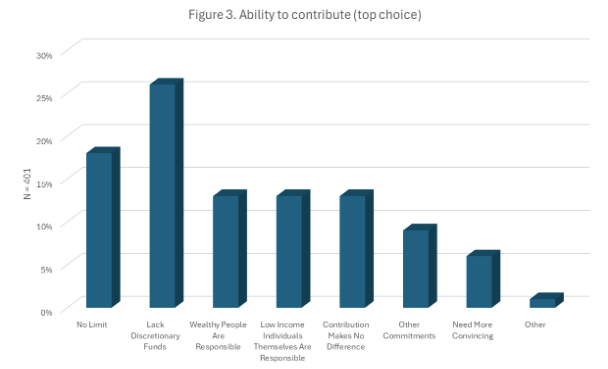
Demographic Response Differences
We collected racial, age (21 to >65), annual family income ($50,000 to > $250,000) and State residence data. Whites/Caucasians (W/C) were overrepresented while Hispanic/Latino/Chicano (HLC) were underrepresented. Blacks/African Americans (Af Am) and Asians /Pacific Islanders (A/PI) matched US census data. The majority of respondents were in the 21-54 age group; there were more respondents from Southern States and the greatest plurality were in the $50,000 to $100,000 income bracket. The income bracket distribution was uniform across racial groups.
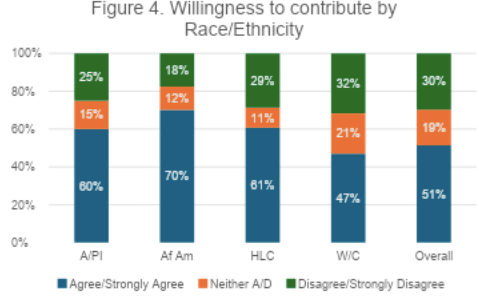
As noted in figure 4 above, there were significant differences among major racial and ethnic groups regarding their willingness to personally contribute to efforts to reduce wealth and income disparity. The differences between Whites and Blacks is the most significant.
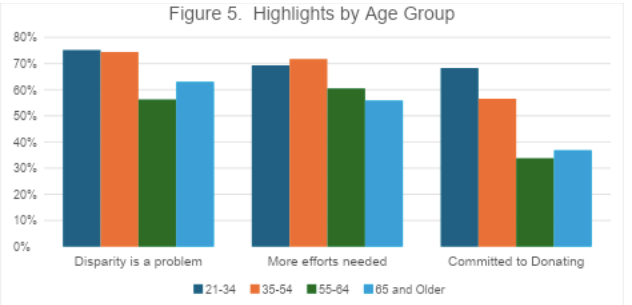
Figure 5 above notes that in general, younger respondents, e.g., those 54 and younger conveyed that wealth and income disparity was a problem and in need of greater efforts.
In reviewing other differences among demographic and survey groups: the pilot and subscriber groups were older and less diverse racially. These groups had a greater percentage who endorsed that wealth and income was a problem and in need of greater effort. On all other issues, their responses were similar to the public survey.
As indicated in the bullets below, respondent age, income and racial differences are highlighted:
- Younger individuals were:
- More concerned about wealth and income inequality.
- More willing to donate
- Likely to have higher income.
- More in favor of guaranteed basic income.
- More in favor of workers’ co-operatives.
- Older respondents were more in favor of skills training and higher education.
- African Americans were:
- More concerned with income inequality.
- In agreement that more efforts are needed.
- Most willing to donate
- The $150,000 – $200,000 income group were the most willing to donate.
Discussion
As WIE endeavors to impact wealth and income disparity, we thought it crucial to get a sense from a sample of Americans regarding their attitudes pertaining to this issue. It was helpful although not surprising to note that a significant majority see wealth and income disparity as a problem and that more effort is needed. It’s cliched to describe and celebrate the individualist American spirit but in contrast and more significant was that most consider mitigation of wealth and income disparity is a shared responsibility.
As we consider efforts to raise funds from a broad cross section of Americans, the response surrounding the willingness to do so and corresponding barriers are crucial considerations. We realize that there are numerous reasons why individuals are unwilling or unable to donate to efforts to mitigate wealth and income disparity. The lack of discretionary income is clearly the most relevant. The lowest (50– 100K) and highest (>250K) income brackets were equally likely to commit to a contribution. Those in the 150– 200K income bracket were significantly more willing to commit to a contribution. The demographic differences also provide food for thought. Younger respondents appear to be more sympathetic and willing to mitigate wealth and income inequality. Perhaps most stark were the racial differences. Whites versus all other racial groups conveyed less concern and less willingness to contribute. This result was most stark between Blacks and Whites where 70% of Blacks versus 47% of Whites were willing to contribute.
However, it is also important to consider minority and qualitative responses. While a significant majority conveyed that wealth and income disparity were problematic, a significant minority disagreed, strongly disagreed or were neutral as to whether it was a problem or in need of more fixing. We invited and received many anecdotal comments, and this is where respondents had the opportunity to amplify their responses. There were two overriding messages represented in the comments. Respondents were emphatic regarding the unfairness of the income and wealth gap and that the wealthy need to step up and take greater responsibility. But there was also a message indicating that lower income individuals need to do more for themselves. A sample of comments follows:
"The wealthy need to do more!"
“A progressive tax system based on those who make the most pay a higher rate is the only fair way to address this problem and then those funds should be used to improve the opportunities for education for those at the bottom.”
“People with higher income brackets should pay more taxes than those who barely get by and are living paycheck to paycheck.”
“With the current administration, the problem is just going to get worse. The tax system must be completely overhauled, there are WAY too many loopholes for millionaires and billionaires.”
“The wealthy are contributing to the erosion of democracy by not contributing fairly based on their income and investments and are paying for legislators who will do their bidding. We are rapidly becoming a third world country.”
"The poorer need to do more for themselves!"
“A lot of wealth disparity is due to the individuals own initiative Getting an education Be willing to get to a job on time.”
“I came from nothing and started working at 15. I went through 30+ years of barely getting by, working smart, learning as much as possible about my profession, making myself valuable to my organization. Through hard work, dedication, saving and investing, I have put myself and my family in the position to live well. I'm 59 now and with 7-8 more years of dedication, et al, i will retire with the resources that will allow me to continue living well and help others. Everyone else should consider following such an example.”
“ I believe in helping those who help themselves.”
Thank you for reading this report. We would love your feedback so please click below to leave comments. We are planning a virtual forum to discuss the above and to share our preliminary ideas and plans to address wealth and income disparity.
Please stay tuned.
